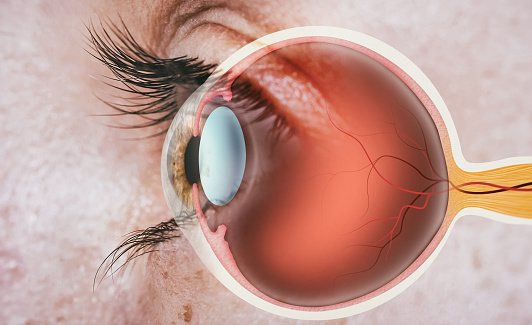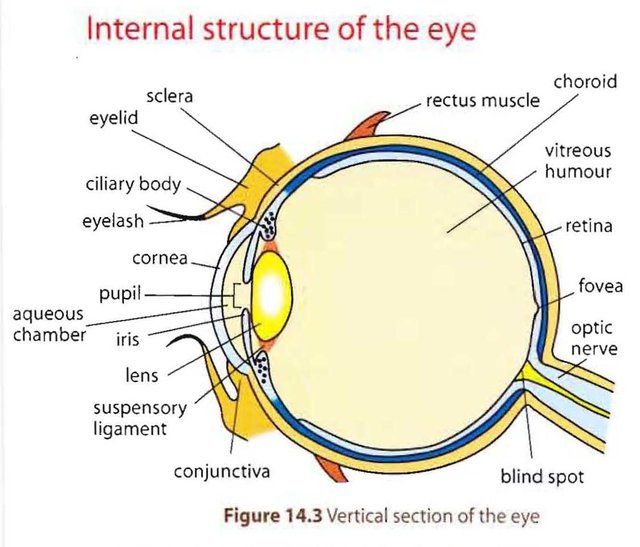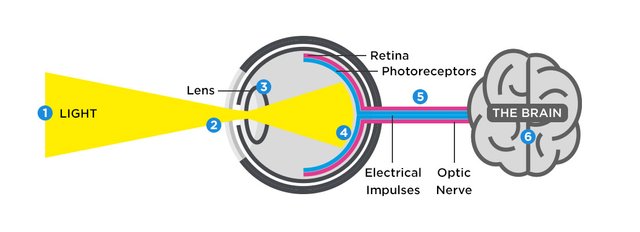Sense of Sight: The Eye
 source
sourceToday we will be learning about the senses of the body with specific reference to the Sense of Sight. Living Organisms can detect changes in their surrounding and react to them appropriately. These stimuli can be Chemical, Mechanical or Thermal. To detect a particular type of stimulus Organisms make use of sense cells or sensory receptors. The human body is comprised of Five Sense Receptors:
I. Sense of Taste
ii. Sense of Sight
iii. Sense of Sensation
iv. Sense of Smell
v. Sense of hearing
However we will just be focusing on the sense of Sight, the organ responsible for this is the Eye. We will be learning about the eye and how it aids in sight and the parts of the eyes that makes sight possible.
Sense of Sight
The Sense of Sight is responsible for our vision, it enables us to see our environment. It provides the most detailed source of sensory information. It is because of our eyes that we know the things around us. Light is the stimulus that makes us this information available. The visual stimulus is spotted by Photoreceptors in the eyes. Many mammals have a pair of eyes placed anteriorly in the head. They produce continuous images like a camera.
Eye: The Organ of Sight
The Eye is a Spherical Organ also called the Eyeball. It is in a bony socketing the skull thus only a small portion of the eyeball are visible. This visible part is protected by the the Lower and Upper eyelid. The tear gland is located under the upper eyelid which produces a Saline Tear Fluid. Blinking causes tear fluid to spread over the eye surfaces cleaning and keeping them damp.
Six set of muscles keep the eyes attached to the eye socket, with this the eye can move in a lot of directions thus expanding the field of vision. One of these muscles is known as the Optic Nerve which connects the eye to the brain.
Structure of the eye
 source
sourceThe eyeball walls is made up of three layers:
i. The Sclera which is the outermost layer
ii. The Choroid the middle layer
iii. The Retina which is the inner most layer.
The Sclera is a tough layer of connective tissue which is white in colour. It protects and maintains the spherical shape of the eyeball. It forms the transparent Cornea. It is perforated to the back by the Optic nerve.
The Choroid is made up of black pigmented cells, it is rich in supply of blood capillaries. It makes up the muscular Ciliary Body and the Iris in front. The lens is held in its position by the suspensory ligaments from the ciliary body. The lens is a flexible, transparent, biconvex structure.
The space in front and behind the lense are filled with watery aqueous humour and jelly like vitreous humour respectively. This helps in the maintenance of the Spherical shape of the eyeball. The Iris is the coloured non-transparent disc of muscular tissue in front of the lens. The Pupil is the hole in the center of the Iris. Thus light enters the eye via the Pupil.
The Retina is the inside layer behind the eyeball that is sensitive to light. It is nourished from the capillaries in the Choroid. It is made up of two Photoreceptors:
i. The rods which are very sensitive to light and are for black and white vision
ii. The cones responsible for color vision
The human eye contains about 125milluon rods and 7million cones.
How we See
 source
sourceWhen we view an object, light rays from each point of the object gains entrance into our eyes. When they pass through the cornea, aqueous humour, lens and vitreous humour, they are refracted and halted to a focus on the Retina to create an image. The image formed is real, inverted and smaller than the actual object. Light rays are refracted most at the cornea surface then the lens makes the final refracting adjustment to focus the rays on the Retina.
When the points of light falls on the Retina to create the image , it stimulates the rods and cones in that area. A pattern of Electrical pulses is sent to the brain via the Optic nerve which interprets the image based on past experience. The brain informs us the position, size and distance of the object from the eye.
Conclusion
The eye is the sense organ for sight, it is a very delicate structure of the body, without the eye we humans and a whole lot of other organisms are unable to see. As we can see above how images are formed and how we are able to recognize those images, it is a thing of wonder and more reasons why we should take care of our eyes very well.
Thank you for contributing to #LearnWithSteem theme. This post has been upvoted by @daytona475 using @steemcurator09 account. We encourage you to keep publishing quality and original content in the Steemit ecosystem to earn support for your content.
Regards,
Team #Sevengers
The #learnwithsteem tag focuses on teaching through tutorials and lessons some knowledge, skill or profession that you have. Please avoid using it if it's not about that. Thank you!